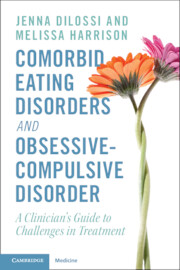 Comorbid Eating Disorders and Obsessive-Compulsive Disorder
Comorbid Eating Disorders and Obsessive-Compulsive Disorder Book contents
- Comorbid Eating Disorders and Obsessive-Compulsive Disorder
- Comorbid Eating Disorders and Obsessive-Compulsive Disorder
- Copyright page
- Contents
- Foreword
- Preface
- Acknowledgments
- Abbreviations
- Part I Overview of the Existing Literature
- Chapter 1 Understanding Eating Disorders
- Chapter 2 Review of Eating Disorder Treatment
- Chapter 3 Understanding Obsessive-Compulsive Disorder
- Chapter 4 Diagnostic Comorbidity and Phenomenological Overlap of Eating Disorders and Obsessive-Compulsive Disorder
- Chapter 5 Identifying Common Themes across Treatments for Eating Disorders and Obsessive-Compulsive Disorder
- Chapter 6 Identifying Mechanisms of Action across Treatments for Eating Disorders and Obsessive-Compulsive Disorder
- Part II Clinical Pitfalls and Treatment Failures
- Part III Evidence-Informed Considerations for Assessment and Treatment
- Part IV Special Topics and Future Considerations
- References
- Index
Chapter 6 - Identifying Mechanisms of Action across Treatments for Eating Disorders and Obsessive-Compulsive Disorder
from Part I - Overview of the Existing Literature
Published online by Cambridge University Press: 14 December 2023
- Comorbid Eating Disorders and Obsessive-Compulsive Disorder
- Comorbid Eating Disorders and Obsessive-Compulsive Disorder
- Copyright page
- Contents
- Foreword
- Preface
- Acknowledgments
- Abbreviations
- Part I Overview of the Existing Literature
- Chapter 1 Understanding Eating Disorders
- Chapter 2 Review of Eating Disorder Treatment
- Chapter 3 Understanding Obsessive-Compulsive Disorder
- Chapter 4 Diagnostic Comorbidity and Phenomenological Overlap of Eating Disorders and Obsessive-Compulsive Disorder
- Chapter 5 Identifying Common Themes across Treatments for Eating Disorders and Obsessive-Compulsive Disorder
- Chapter 6 Identifying Mechanisms of Action across Treatments for Eating Disorders and Obsessive-Compulsive Disorder
- Part II Clinical Pitfalls and Treatment Failures
- Part III Evidence-Informed Considerations for Assessment and Treatment
- Part IV Special Topics and Future Considerations
- References
- Index
Summary
Psychological treatments for eating disorders (EDs) and obsessive-compulsive disorder (OCD) have been shown to be effective in many studies. The specific mechanisms of change in treatments for EDs are not entirely clear, but it is suggested that psychoeducation, collaboration, exposure-based interventions, cognitive therapy, interpersonal effectiveness, and value-based interventions may be active treatment ingredients. Psychoeducation and collaboration between patient and therapist are essential to provide information about the disorder and its causes, challenge negative appraisals and self-criticism, and foster a collaborative environment. Exposure and behavioral experiments are often used in the treatment of both disorders. The goals of exposure include reducing anxiety by repeated contact with a feared stimulus and eliminating avoidance, safety, or escape behaviors, as well as increasing distress tolerance and extinction learning. Cognitive therapy, interpersonal effectiveness, and value-based interventions in ED treatment aim to increase self-efficacy and self-esteem through decreasing interpersonal problems and shifting values that are based on appearance.
Keywords
- Type
- Chapter
- Information
- Comorbid Eating Disorders and Obsessive-Compulsive DisorderA Clinician's Guide to Challenges in Treatment, pp. 40 - 48Publisher: Cambridge University PressPrint publication year: 2023
